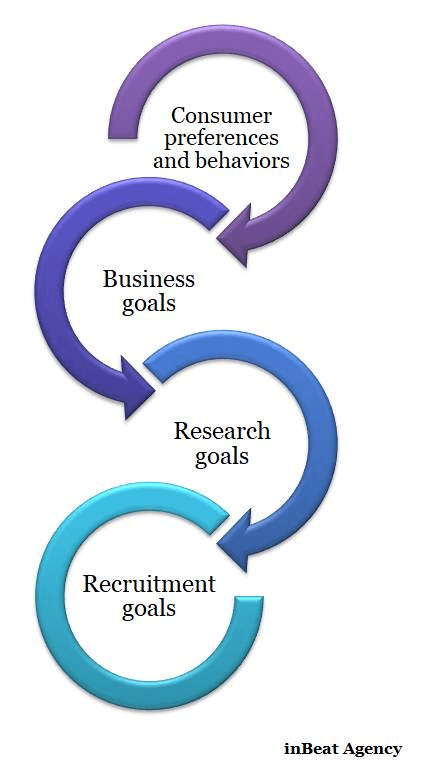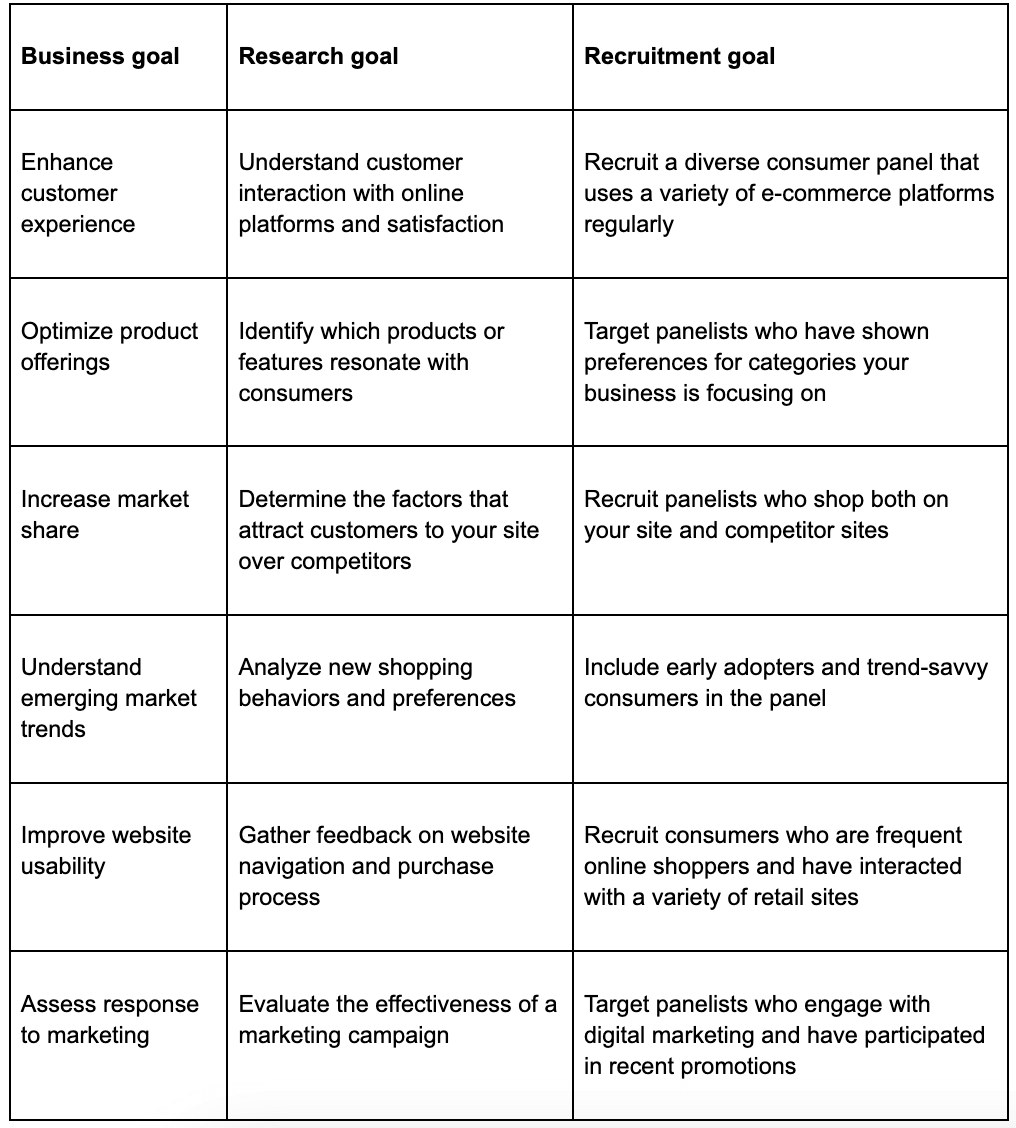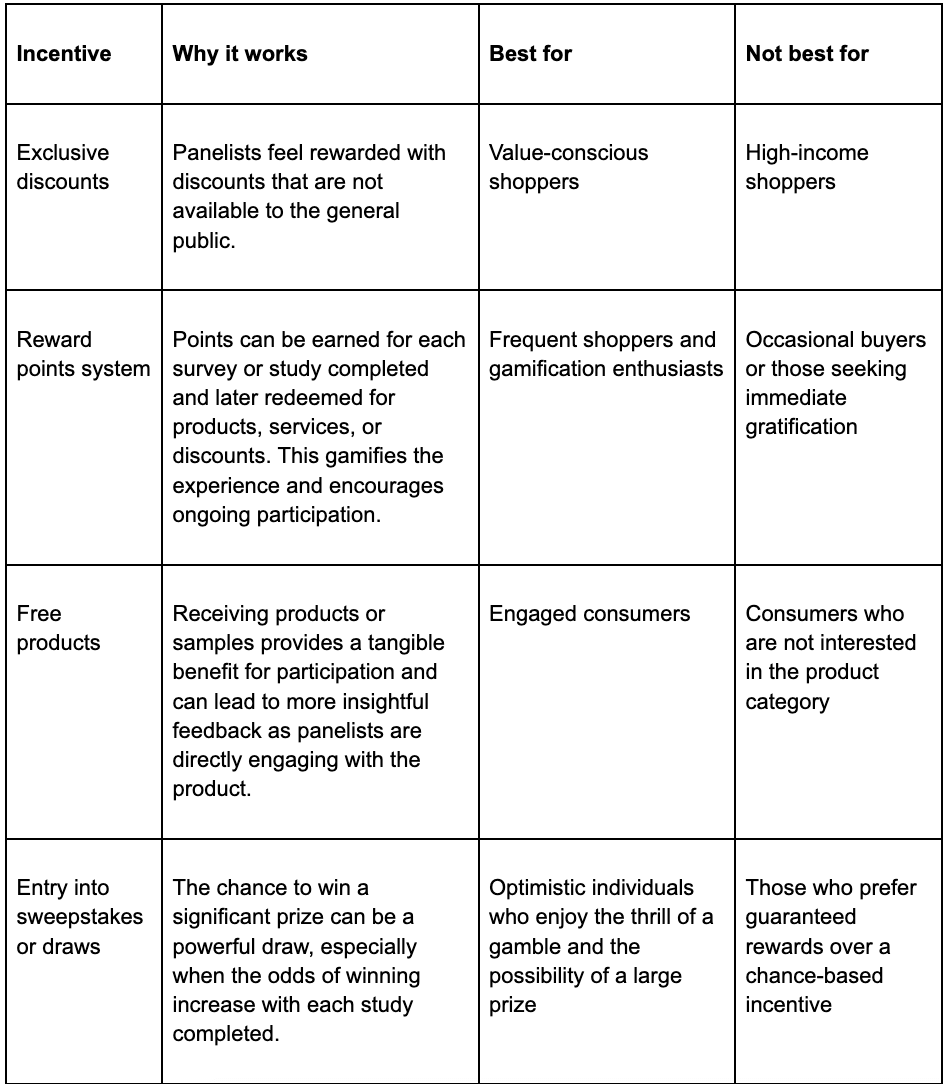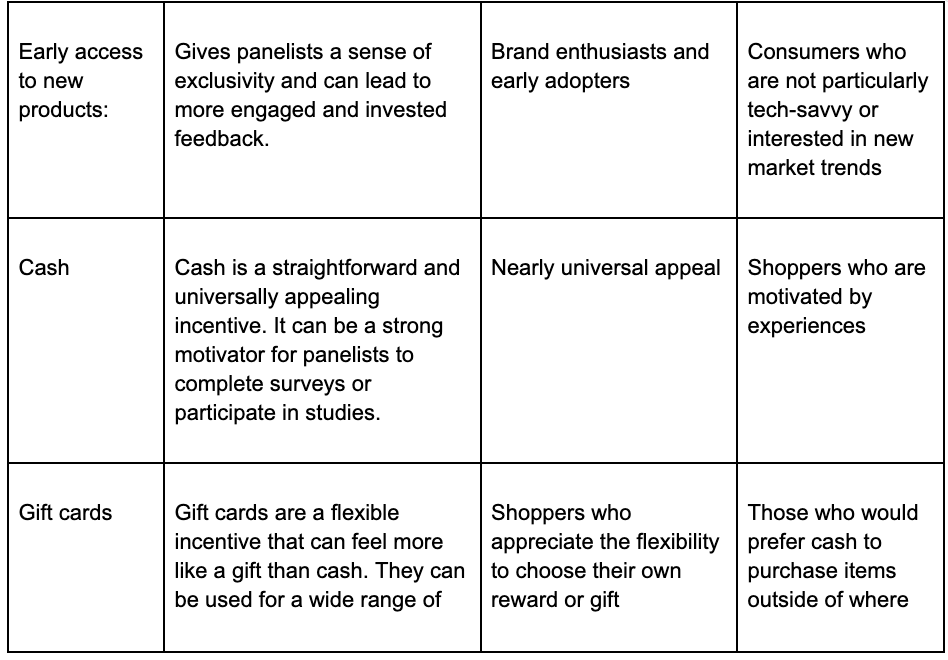Consumer panel recruitment in the eCommerce and retail sector has unique challenges, such as a broad range of audiences with diverse needs.
Maintaining panelist engagement and reducing incentive bias to ensure authentic feedback are not easy either.
You’re reading the right article to solve these issues, though.
We’ll use our experience in the panel recruiting niche to discuss:
- Your audience’s particularities and how to target them effectively
- How to set recruiting goals that reflect your research and business goals
- 10 types of incentives and who they work for
- How to turn consumer feedback into actionable strategies
Bonus: Plenty of insider tips and pages from our agency’s work, plus surprise case studies.
Let’s dive in.
TL;DR:
- Unique challenges: Consumer panel recruitment faces challenges like a diverse audience and maintaining engagement while reducing incentive bias.
- Key focus areas:
- Understanding consumer demographics: Analyzing age, gender, income, etc., for effective targeting.
- Consumer preferences and behaviors: Using surveys and social media analytics to understand likes, dislikes, and shopping trends.
- Competitor analysis: Studying competitors’ consumer base for broader market insights.
- Identifying online shopping trends: Analyzing shopping patterns, engagement, and technological preferences.
- Setting recruitment goals: Aligning panel recruitment with research and business objectives.
- Recruitment strategies:
- Social media advertising: Targeting ads based on consumer interests.
- Referral programs: Incentivizing current customers to refer others.
- Email marketing: Personalized email campaigns.
- Content marketing: Engaging content with calls-to-action.
- Influencer partnerships: Collaborating with relevant influencers.
- Incentivizing participation: Choosing incentives like discounts, reward points, or free products, while balancing real engagement.
- Maintaining engagement: Regular communication, feedback loops, varied participation formats, and recognition programs.
- Analyzing consumer insights: Steps include data aggregation, thematic analysis, benchmarking, and developing actionable strategies.
Step 1: Before Panel Recruitment. Understand the eCommerce and Retail Consumer
Tl;dr: Focus on comprehending the demographics, behaviors, preferences, and shopping patterns of consumers in the e-commerce and retail sectors.
Any recruitment process, whether you're doing an online research panel or another market panel, needs a representative sample from your target market.
This will help you tap into the right pool of participants, and, equally important, ensure high participation rates.
But to do that, you must understand your customer database first.
Gaining this understanding helps target and recruit a representative panel of consumers effectively.
Basically, you can design recruitment strategies and communication that resonate with the target audience, ensuring the panel reflects the actual consumer base you serve.
Here’s how you can do that: understand your consumer, their shopping trends, and your competition.
How to Profile the Modern e-Commerce and Retail Consumer
Follow the steps below to find the right potential participants for your market research panels:
- Conduct a demographic analysis: Collect demographic data such as age, gender, income level, education, and geographic location. Use customer data from your existing database or acquire it from market research firms. This helps understand who your customers are and tailor your recruitment messages accordingly.
- Explore preferences: Conduct surveys or focus groups to gather information about consumer likes, dislikes, needs, and wants. An online survey asking customers about their preferred shopping times, product categories, and feedback on user experience is a great start.
- Run psychographic profiling: Assess the lifestyle, values, attitudes, and interests of your consumers. Use social media analytics to understand the lifestyle and interests of your consumer base. This helps you recruit a panel that aligns with the values and lifestyles of your broader customer base.
- Use feedback and review analysis: Analyze customer feedback, reviews, and ratings to understand customer satisfaction and areas of concern. This allows you to recruit panelists who can provide constructive feedback on areas crucial to your consumer base.
Insider tip: At inBeat, we always include a competitor analysis in our market research survey plans. We advise you to do the same for your panel recruitment services.
Understanding the consumer base of your competitors allows you to broaden your understanding of the market and get faster insights. Therefore, you can recruit panelists who can provide in-depth insights not just specific to your brand but to the industry as a whole. A good way to start is to analyze public reviews and social media activity of competitor brands to gain insights into what consumers value in your industry.
How to Identify Trends and Behaviors in Online Shopping
After having a thorough understanding of who your customers are, you should understand what your customers do.
Regardless of the market research methods you'll use, this step will help you get quality insights.
Insider tip: Behavior patterns might reinforce the sociodemographic profiles, but sometimes, contradictions can also arise. And it’s your job to follow the data.
Below are the variables we explore at inBeat:
- Shopping patterns analysis: Study shopping frequency, average spend, and seasonal variations in shopping behavior. This helps you segment consumers based on their shopping habits and identify the most relevant panelists. For example, you can examine sales data to identify peak shopping times and the types of products bought during different seasons.
- Engagement pattern study: Look into how consumers engage with your brand across different channels. Understanding which channels are most effective for communication can help in reaching potential panelists more effectively. As such, track engagement through social media likes, comments, and shares, email open rates, and responses to marketing campaigns.
- Technological affinity assessment: Determine the level of comfort and frequency of use of various technologies by your consumers. For example, you can identify if your consumers are more inclined to use mobile apps or desktops for shopping. This helps you ensure that the mode of communication and panel management tools align with the technological preferences of your panelists.
- Use data analytics tools: This helps you get deeper insights to stay ahead in understanding evolving consumer profiles and preferences. One solid example is using AI-driven analytics to predict future market dynamics based on current data.
Surprise Case Study
Every eCommerce store is different, but let’s say we own Solo Stove. Here’s how a complex analysis would look for a solid list of panelists:
- Demographic details: Solo Stove's products, such as outdoor fire pits and pizza ovens, likely appeal to a range of demographics. However, they may particularly attract middle to upper-income groups, given the nature and pricing of the products. The products may also appeal to a range of ages but could be particularly popular among homeowners, which often skews towards an older demographic.
- Psychographic profiling: Understanding the lifestyle and values of Solo Stove’s customers, like an inclination towards outdoor activities, environmental consciousness, or a preference for high-quality, durable goods, can be crucial. This helps in aligning the panel recruitment with these lifestyle traits and get good feedback from respondents throughout the entire recruitment process.
- Preference exploration: Surveys or feedback forms could be used to understand why customers prefer certain products, such as the portability of camp stoves or the aesthetics of fire pits. This information can guide product development and marketing strategies.
- Behavioral insights: Analyzing customer interactions on the site, like which products are viewed the most or added to the cart, can reveal popular items or emerging trends. For example, if fire pits are frequently viewed, it indicates a strong interest in outdoor living products.
- Shopping patterns analysis: Tracking when customers make purchases (e.g., seasonal peaks for outdoor equipment) and their spending patterns (average purchase value) can help in targeting the right consumers at the right time for panel recruitment.
Step 2: Set Recruitment Objectives for Your Customer Panel
Setting precise and achievable goals for customer panel recruitment is essential because your recruitment strategies must be a reflection of your overarching business objectives.
And your business goals hinge on a deep understanding of your consumer base.
To effectively set these recruitment goals, you need to comprehend your research objectives—what you want to discover about your consumers' behavior and preferences.

Research objectives in the e-commerce and retail sector may involve analyzing:
- Market positioning in the e-commerce landscape.
- Consumer purchasing behaviors and trends.
- Competitive advantages in product offerings or user experience.
- Actionable insights to inform marketing and product development strategies.
- Customer sentiment regarding new product launches or website features.
- Seasonal and promotional shopping patterns.
Below is a table illustrating how your recruitment goals correlate with specific research aims and broader business aspirations.
Insider tip: Review the table to identify your business objective. Then, follow up the corresponding research and recruitment goals to formulate accurate objectives for your upcoming panel of customers.

Insider tip: A quality panel reflects the diversity of your consumer base in terms of demographics, geographic locations, and shopping behaviors. For instance, if your e-commerce platform caters to a wide age range, your panel should too.
Step 3: Choose the Right Panel Recruitment Strategies for e-Commerce and Retail
The next step is setting your recruitment strategies. At inBeat, we have experienced the most success with paid social media ads, specifically influencer content.
Here are some results our client NielsenIQ got internationally:

Bragging aside, here are five panel recruitment strategies tailored for online consumers, complete with actionable advice and step-by-step processes.
1. Leverage Social Media Advertising
- Identify which social media platforms your target consumers frequent.
- Create engaging ads that speak to the interests and needs of your target demographic.
- Use targeting features to reach potential panelists based on their behavior and interests.
Insider tip: Test different ad formats and messaging to see which resonate best with your audience. Monitor engagement and iterate accordingly.
2. Implement Referral Programs
- Develop a referral program that incentivizes current customers to refer peers.
- Offer rewards that are valuable to your customer base, such as monetary incentives, discounts or exclusive access.
- Promote the referral program prominently across your website and communications.
- Getting more referrals into your program ensures a higher completion rate because these demographic profiles are likelier to fit your existing target market.
Insider tip: Make the referral process as easy as possible. Provide shareable links or codes that current customers can easily pass along.
3. Use Email Marketing
- Collect potential panelists' email addresses and connect them in your panel management software.
- Craft personalized email campaigns that invite customers to join your panel.
- Segment your email list to tailor the invitation to specific consumer behaviors and preferences.
- Follow up with reminders, but avoid spamming.
Insider tip: Highlight the benefits of joining the panel, such as influencing future products or gaining early access to sales.
4. Engage Through Content Marketing
- Create valuable content that aligns with your consumers' interests, like blog posts or videos.
- Include calls-to-action (CTAs) within the content that invite readers/viewers to join the panel.
- Use SEO strategies to increase the visibility of your content.
Insider tip: Position panel membership as an exclusive community for enthusiasts and insiders.
5. Partner with Influencers
- Identify influencers who align with your brand values and have an engaged audience.
- Collaborate with them to spread the word about your panel recruitment.
- Create unique hashtags or campaigns that influencers can use to track engagement.
Influencer marketing is an innovative tool in panel recruitment, but it's very useful. After all, influencers can persuade your exact target market to join, so your panel composition will be very reflective of that.
Insider tip: Choose influencers who genuinely use and like your products, as their recommendations will feel more authentic.
Insider story: For NielsenIQ, we onboarded over 100 international UGC creators, influencers, and voice actors to generate multi-lingual content in 15+ different languages and accents. That’s how we optimized panel acquisition in over 15 countries with a minimal budget:

Side note: Each of these strategies should be tailored to fit the unique profile of your target consumer as established in the profiling process. The more aligned your recruitment strategies are with the preferences and behaviors of your consumers, the more effective they will be. Remember to track the performance of each strategy and adjust as needed for maximum efficacy.
Surprise Case Study
You have learned hard so far, so let’s see how these panel recruiting strategies come into real action with Solo Stove.
Leverage Social Media Advertising
- Identify outdoor and home lifestyle-focused platforms like Instagram and Pinterest.
- Create ads showcasing the communal and cozy aspect of a fire pit or the fun of outdoor cooking with a Solo Stove pizza oven.
- Target ads to users who follow outdoor living, camping, and DIY home improvement profiles.
What we’d do better: Run a targeted campaign during early spring when people start thinking about outdoor activities.
Implement Referral Programs
- Encourage existing customers to refer friends by offering them a discount on their next purchase or exclusive accessories.
- Offer a unique accessory or a starter pack (like fire starters) as a reward for referrals.
- Highlight the referral program via the Solo Stove newsletter and checkout process.
What we’d do better:
- Create an easy-to-use referral code system.
- Display the referral program prominently on the homepage and during the post-purchase phase.
Use Email Marketing
- Send out an email campaign to customers who have previously purchased or shown interest in outdoor products.
- Personalize the emails with the customer’s name and reference their past purchases or product interests.
- Emphasize how their feedback can shape the future of outdoor living products.
What we’d do:
- Segment the email list based on customer purchase history.
- Design an email template that resonates with the outdoor lifestyle.
Engage Through Content Marketing
- Create blog posts or videos on topics like “Maximizing Your Outdoor Space” or “Eco-Friendly Backyard Tips.”
- Include a CTA for joining the panel at the end of each piece of content.
What we’d do: Use SEO by targeting keywords related to outdoor living and eco-friendly practices.
Partner with Influencers
- Collaborate with key influencers who are known for outdoor living, camping, or home and garden improvements.
- Have influencers create content using Solo Stove products and talking about the value of customer feedback.
- Use a campaign hashtag like #SoloStoveInsights to track the campaign’s reach and engagement.
What we’d do better:
- Tap into our extensive network of influencers and content creators who are vetted and among the top 4% in their niches.
- Provide influencers with a unique sign-up link to track the number of recruits they bring in.
For each strategy, Solo Stove should ensure that the messaging aligns with the brand's ethos of enjoying the outdoors and the community-building aspect of their products. They should also monitor which strategies yield the highest engagement and adjust their tactics accordingly to maintain a panel that is both representative and enthusiastic.
Step 4: Incentivize Participation for e-Commerce and Retail Customer Panels
Incentivizing participation can be a daunting task, but it's one of the most important aspects of panel recruitment, especially if you want to maintain a high completion rate.
The process is simple:
- Decide on incentives that are attractive to your target audience, like gift cards or product samples.
- Publicize the incentives across your marketing channels.
- Ensure the sign-up process is straightforward, and the rewards are delivered promptly.
Insider tip: Be clear about the terms of the incentives and maintain transparency about how panelists' data will be used.
As a panel recruiting agency, we’ve seen firsthand how the lack of transparency affects the recruiting process, decreasing response rates and increasing the number of people who leave the panel.
It’s also essential to balance incentives with real engagement.
Incentives alone may attract participants interested only in rewards, potentially skewing results. Genuine engagement ensures panelists are invested in the brand and provide authentic, valuable insights. It creates a panel of loyal customers who are motivated by more than just compensation. And this leads to higher-quality feedback and more reliable data for decision-making.
This balance contributes to a sustainable panel community where members are enthusiastic and responsive, providing a well-rounded perspective that truly represents consumer sentiment and behavior.
That said, here’s a table with incentives you can consider and who they work/ don’t work for:


Step 5: Maintain Engagement with Panel Members
Maintaining engagement with panel members is critical for the longevity and success of consumer research efforts.
Here’s a page of our playbook to keep panel members active and interested:
- Regular communication: Keep in touch with panel members through frequent updates. Inform them about how their feedback is being used and the impact it has on your products or services.
- Engagement surveys: Periodically survey panel members to ask for their opinions on the panel process itself and how it can be improved.
- Incentive refreshment: Evaluate and refresh the incentives offered periodically to ensure they remain appealing and relevant to your panel members.
- Feedback loop: Create a feedback loop where panelists can see the results of their input, such as changes made to products or services based on their suggestions. Listen to the feedback from panel members about the panel itself and adapt your strategies accordingly. If they suggest more mobile-friendly surveys or shorter questionnaires, consider implementing these changes.
- Community building: Foster a community among panel members by offering forums or social media groups where they can interact with each other and feel part of a larger effort.
- Varied participation formats: Offer various ways to participate in research, such as online panels, interviews, focus groups, or product testing. This wide range of options keeps the experience interesting and increases the response rates.
- Personalization: Personalize communications as much as possible. Use the data you have on panel members to tailor interactions and make them feel recognized as individuals.
- Responsive support: Provide quick and helpful responses to any queries or issues that panel members might have.
- Transparent policies: Ensure your privacy and data policies are transparent and that members understand how their information is used and protected.
- Recognition programs: Implement recognition programs for the most active or insightful panel members. Highlighting their contributions can encourage continued participation.
Step 6: Analyze Consumer Insights
This is the most important part: turning panel feedback from each customer sergment into actionable business strategies.
Analyzing consumer insights from a recruiting panel in e-commerce and retail involves several key steps to effectively interpret and leverage the data gathered.
Here’s the structured approach we’re using at inBeat:
1: Data Aggregation
- Gather data: Collect insights from the panel, including survey responses, interview transcripts, focus group discussions, and any other relevant feedback.
- Integrate data sources: Combine panel data with other customer data streams, like purchase history, website analytics, and customer service interactions.
2: Categorization and Segmentation
- Categorize responses: Organize the data into relevant categories such as product feedback, website usability, customer service experiences, etc.
- Segment the data: Break down the insights by customer demographics, behavior patterns, and purchase history to identify trends within specific groups.
3: Qualitative Analysis
- Thematic analysis: Identify common themes and sentiments from open-ended responses and discussion notes.
- Contextual understanding: Interpret the qualitative data by considering the context of responses, like current market trends or recent changes in your e-commerce platform.
4: Quantitative Analysis
- Statistical analysis: Apply statistical methods to quantify data, such as calculating the frequency of certain types of feedback or measuring satisfaction scores.
- Trend identification: Look for patterns over time, like changes in customer sentiment or the rising popularity of certain products or features.
5: Comparative Analysis
- Benchmarking: Compare insights with industry benchmarks or competitor data to gauge your performance and identify areas for improvement.
- Historical comparison: Compare current insights with past data to track changes in consumer behavior and preferences.
6: Insight Synthesis
- Draw conclusions: Synthesize both qualitative and quantitative findings to draw comprehensive insights about your consumer base.
- Identify actionable insights: Focus on insights that can lead to actionable strategies, such as product improvements, marketing adjustments, or customer experience enhancements.
7: Reporting and Visualization
- Create reports: Compile the findings into clear, concise reports for different stakeholders.
- Data visualization: Use charts, graphs, and infographics to make the data more accessible and understandable.
8: Strategy Development
- Develop action plans: Based on the insights, create strategies to address identified issues or opportunities.
- Collaboration: Work with different departments (like marketing, product development, customer service) to implement these strategies.
9: Continuous Monitoring and Feedback Loop
- Monitor changes: Continuously monitor consumer feedback and market trends to assess the impact of implemented strategies.
- Feedback loop: Incorporate new insights back into the business strategy and panel discussions, creating a dynamic, responsive approach to consumer feedback.
Final Surprise Case Study: Solo Stove – Transforming Panel Feedback into Actionable Business Strategies
Background: Solo Stove, known for its innovative outdoor fire pits and camping stoves, established an online panel to gather insights on product use, customer experience, and market dynamics to identify potential areas for growth.
Panel Feedback:
- Ease of portability: Many panel members expressed that while they loved the efficiency of Solo Stove products, they desired more portable options for camping trips.
- Accessory diversity: A significant portion of feedback highlighted a lack of variety in accessories, especially for the fire pits.
- Environmental concerns: Some panelists raised concerns about environmental impact and expressed interest in more eco-friendly products and packaging.
- Online shopping experience: Feedback indicated that the website’s product comparison feature was not user-friendly, making it difficult for customers to decide between models.
Transforming Feedback into Business Strategy
Feedback: Need for more portable options.
Strategy: Develop a new line of lightweight, compact fire pits and stoves, specifically designed for portability. Incorporate design elements based on specific feedback, like foldable parts and ergonomic handles.
Implementation: Collaborate with the R&D department to prototype designs, conduct beta testing with the panel, and launch a targeted marketing campaign for the new line.
Feedback: Limited accessory options.
- Strategy: Introduce a wider range of accessories, such as customizable grill plates, weather-resistant covers, and unique fire-starting tools. Offer bundle deals with fire pits to enhance customer value.
- Implementation: Work with product teams to design new accessories and use panel feedback for initial reviews. Launch these new products with an email campaign targeting existing customers.
Feedback: Sustainability imperative.
- Strategy: Develop a sustainability program focusing on eco-friendly materials for both products and packaging. Implement a recycling program for old products.
- Implementation: Partner with sustainable material suppliers and communicate these eco-friendly changes through a dedicated sustainability section on the website and social media channels.
Feedback: Inefficient product comparison feature.
- Strategy: Redesign the website's comparison tool to be more intuitive and informative, possibly incorporating a guided questionnaire to help customers choose the right product.
- Implementation: Work with web developers to overhaul the comparison feature. Use A/B testing with a segment of the panel to refine the user interface before a full rollout.
Continuous Monitoring and Adaptation
After implementing these strategies, Solo Stove will continue to gather panel feedback to monitor the effectiveness of these changes and make continuous improvements. This includes tracking sales data, website engagement metrics, and direct customer feedback.
Wrapping Up
This guide took you through the intricacies of consumer panel recruitment in eCommerce and retail.
You now know how to start an effective market research panel, from understanding your consumers, setting your goals, targeting them effectively, and turning their feedback into strategy.
You’ve also seen a real-time example for Solo Stove – who can now comfortably copy the entire recruiting plan if they ever need one.
Insider tip: If you need a customized panel recruiting strategy, set a free strategy call.
We’ll analyze your demographics, competition, and market position to power up your panel recruiting efforts.

